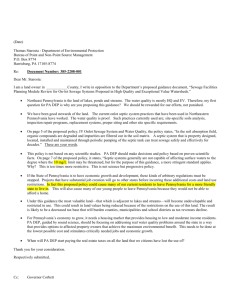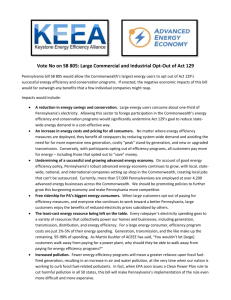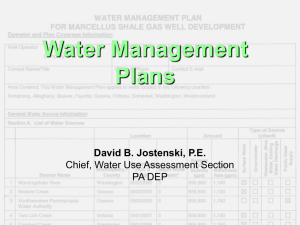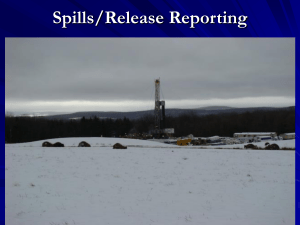PA_Pafford_20141125h
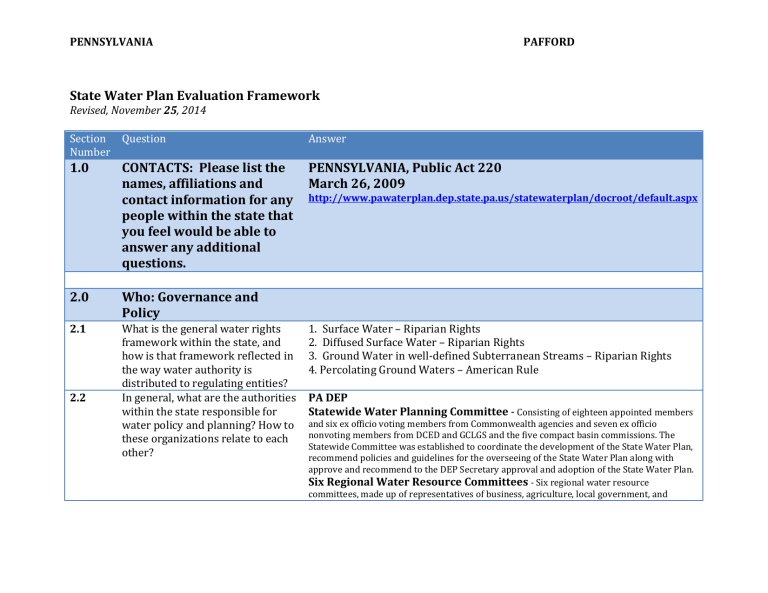
PENNSYLVANIA PAFFORD
State Water Plan Evaluation Framework
Revised, November 25, 2014
Section
Number
Question Answer
1.0
2.0
CONTACTS: Please list the names, affiliations and contact information for any people within the state that you feel would be able to answer any additional questions.
Who: Governance and
Policy
PENNSYLVANIA, Public Act 220
March 26, 2009
http://www.pawaterplan.dep.state.pa.us/statewaterplan/docroot/default.aspx
2.1
2.2
What is the general water rights framework within the state, and how is that framework reflected in the way water authority is distributed to regulating entities?
In general, what are the authorities within the state responsible for water policy and planning? How to these organizations relate to each other?
1. Surface Water – Riparian Rights
2. Diffused Surface Water – Riparian Rights
3. Ground Water in well-defined Subterranean Streams – Riparian Rights
4. Percolating Ground Waters – American Rule
PA DEP
Statewide Water Planning Committee Consisting of eighteen appointed members and six ex officio voting members from Commonwealth agencies and seven ex officio nonvoting members from DCED and GCLGS and the five compact basin commissions. The
Statewide Committee was established to coordinate the development of the State Water Plan, recommend policies and guidelines for the overseeing of the State Water Plan along with approve and recommend to the DEP Secretary approval and adoption of the State Water Plan.
Six Regional Water Resource Committees - Six regional water resource committees, made up of representatives of business, agriculture, local government, and
PENNSYLVANIA PAFFORD
2.3
2.3.1
2.3.2
2.3.3
2.3.4
2.3.5
2.4
To the extent that you can, please describe which entities do the following:
- planning environmental interests will oversee creation of water plans on local levels. The regional committees will take public comment and recommend regional water plans to the Statewide
Water Resources Committee, created by the Act.
Watersheds are further defined into 104 Major Watersheds (1998): The SWP, originally developed in the 1970s, divided Pennsylvania's major river basins into 20 smaller units
(subbasins) for planning purposes. Most of these subbasins are further divided into watershed areas (designated "A", "B", "C" etc.) that range in size from about 100 to 1000 square miles. http://www.pasda.psu.edu/data/gap/ancillary/covs/pasheds104.html
- implementation
- enforcement
- policy development
- legislation development
Please describe any conflict resolution process the state has
Regional Committees, with input from other intra and inter-state stakeholders, submit recommendations and priorities to the Statewide
Committee for review, approval and incorporation into the SWP. The DEP shall draft and develop the SWP with guidance and input from the Statewide
Committee. (Public Act 220, § 3111. (a) Preparation and adoption)
The Statewide committee, the regional committees and the department - shall cooperate and coordinate with appropriate Compact Basin Commissions and
Federal, interstate, State and political subdivisions, municipalities, public water supply agencies and other agencies for efficient planning for the maintenance and enhancement of the water resources of this Commonwealth.
(Public Act 220,§ 3103)
DEP
DEP
DEP/Statewide Committee
DEP generates legislation based on input from Statewide Committee.
If conflict arises among several uses with the same priority, each user is required to limit their diversion amounts to reasonable uses that do not
PENNSYLVANIA PAFFORD
2.5
2.6
2.7 specifically related to water issues. diminish flow. These priorities do not take into account the time that the users began withdrawing water from the source. 1
[Percolating Groundwater] Liability can only arise where withdrawal is malicious, negligent, or causes foreseeable harm to adjacent lands.
2
Conflicts over water rights are currently resolved through Pennsylvania courts.
3
What provisions are there for stakeholder participation in water planning and decision making?
What is the relationship between water planning, water policy development and legislation (does the plan include policy or support policy developed elsewhere)
What interstate authorities do these groups work with? What regional entities or agreements does the state participate in?
PA 220 § 3113. Regional committees (b) membership (ii) discusses the 17 member, governor-appointed, stakeholder groups required to compose each of the Six Regional Basin Committees. Recommendations for each of these seats are made by separately by State and regional interest groups. These
Regional Committees make recommendations and work closely with the
Statewide Committee, comprised of 18 members of various stakeholder groups (PA 220 § 311(b)) These Committees all conduct open meetings.
Historically, PA’s water planning has been a fragmented set of disconnected policies and planning efforts. The 2009 SWP strives to form a more integrated process, encompassing a wider range of topics (eg. land use) based on input from Regional Committees. The 2009 Plan included nine recommended
Legislative priorities of the Statewide Water Resources Committee.
Delaware River Basin Compact, 32 P.S. §815.101 et eq.(1961)
Susquehanna River Basin Compact, 32 P.S. §820.1 et seq.(1970)
Boundary Waters Treaty of 1909 (US and Canada)
Great Lakes Basin Compact,32 P.S. §817.1 et seq.(1956)
WRDA 1986, as amended 2000, 42 U.S.C. §1962d-20
Great Lakes Charter of 1985
Great Lakes –St. Lawrence River Basin
1 Basic Use and Monitoring of Water Resources in Pennsylvania(April 2003) originally sourced from R. Timothy Weston, Water Resources Management and Land Use in Pennsylvania, at 6 (2002).
2 Basic Use and Monitoring of Water Resources in Pennsylvania(April 2003) originally sourced from R. Timothy Weston, Water Resources Management and Land Use in Pennsylvania, at 8 (2002).
3 Basic Use and Monitoring of Water Resources in Pennsylvania(April 2003)
PENNSYLVANIA PAFFORD
2.8
3.0
3.1
3.2
Other: please list any other observations related to water governance and policy within the state
Planning, Administration and Implementation
What is the planning horizon, how many years ahead do they plan for?
What is the planning cycle? How often is the plan updated
How is water planning funded?
Sustainable Water Resources Agreement (12/2005) 4 interstate Basin Commissions (8 total) - Susquehanna River Basin
Commission, Delaware River Basin Commission, Partnership for the Delaware
Estuary, Great Lakes Commission, Interstate Commission on the Potomac
River Basin, Ohio River Valley Water Sanitation Commission, Chesapeake Bay
Commission, Chesapeake Bay Program 5
If Pennsylvania follows other state’s examples, the legislature may create a quasi-independent Water Resource Board to regulate water use or approve water planning, separate from the
DEP.
6
15 years
5 years
3.2 PA 220, § 3131. Administration.
(a) Use of funds.—The department shall use fees collected from the use of the Statewide data system to defray the reasonable costs of administering sections 3117 (relating to Statewide data system) and 3118 (relating to water use registration and reporting).
(d) Water Resources Fund.—Fines and penalties collected under this chapter shall be paid into the State Treasury in a special fund known as the
Water Resources Fund. This fund shall be administered by the department to carry out the purposes of this chapter.
4 A Short Review of Pennsylvania Water Law, 2006
5 http://www.dep.state.pa.us/river/iwo/rbc/rbc.htm
6 Basic Use and Monitoring of Water Resources in Pennsylvania (April 2003)
PENNSYLVANIA PAFFORD
3.4
3.5
3.6
3.7
3.8
3.3 What data and models are used and how are they acquired?
How is water allocation policy connected to water planning and legislation development, formally?
What is the relationship to other planning processes within the state such as land use planning, economic development planning, etc
How are stakeholder interests incorporated into the planning process?
Are water information security and
FOI concerns addressed?
Other: are there any other important aspects of this state’s actually planning process that we should note?
(e) Use of other funds.—Money in the Clean Water Fund established by the act of June 22, 1937 (P.L. 1987. No.394), known as The Clean Streams
Law, may be used by the department for purposes of this chapter.
PA 220, § 3117 requires the creation of a Statewide Data System dedicated to water resources. Currently, PA DEP offers the following on their website:
1) Digital Water Atlas: an interactive tool to learn more about PA water issues
2)e-map PA: analytical mapping tool for displaying and analyzing relevant environmental data
3)WAVE: analytical mapping tool for water-related resources
4)Water Use Data Download Tool: an application to download data pertaining to water withdrawals and use
Direct linkages are not specifically addressed in the water plan, however several of the Regional Committees listed the need to create/develop these relationships as one of their two main priorities.
The Six Regional Basin Committees are comprised of multiple stakeholders from various interest groups, who make recommendations to the Statewide
Committiee, also comprised of multiple stakeholders..
Not specifically addressed.
PENNSYLVANIA PAFFORD
4.0
4.1
4.4
4.3
4.4
4.4.1
4.4.2
What Water: Resource
Scope
What spatial scale is the plan, are the planning units (basins, regions, and/or state)
What water is planned: surface water, groundwater
Six major regional basins (p3, ES): Great Lakes, Ohio, Delaware, Lower
Susquehanna, Upper/Middle Susquehanna, Potomac
Whose water is planned: Public vs. private? What is the relationship to water rights?
Please note how the following potential uses of water are planned for
withdrawals
1. Surface Water
2. Diffused Surface Water
3. Ground Water in well-defined Subterranean Streams
4. Percolating Ground Waters
Public. Registration and reporting requirements are put in place for large water consumers (10,000+ gpd).
discharges
In addition to requiring users that withdraw more than 10,000+ gpd over a 30 day period to register with PA DEP and periodically provide updated reports, the SWP includes 3 recommendations for withdrawals and water use:
1) Concentrate outreach efforts
2)Develop 20 year water use projections for each watershed, and evaluate major use trends
3)Concentrate efforts to evolve PA’s water rights and withdrawal arrangements
Fall under the Federal Clean Water Act NPDES permit regulations
9/28/2002 PA DEP publishes Comprehensive Stormwater Managent Policy requiring good planning and BMP’s to reduce stormwater discharge
Abandoned mines discharging acidic runoff is a major concern in many regions.
PENNSYLVANIA PAFFORD
4.4.3
4.4.4
4.4.5
4.4.6
4.4.7
4.4.8
4.4.9
stormwater reuse & conservation
In coordination with US Geological Survey and the Water Analysis Screening
Tool (WAST), DEP is using the Water Use Data System (WUDS) to compile information on use and discharges for future recommendations.
Discharges are a critical component in CWPA designations.
SWP Recommendations: One of the most robust sections discusses the subcategories of Flood Control and Stormwater Management
Along with the 8 recommendations included in the State Water Plan, DEP is also charged with implementing a Water Resources Technical Assistance
Center to promote water conservation and efficiency. 7
PA 220 § 3120 lists the 8 functions the WRTAC is charged with.
environmental/in-stream
industry Commercial shipping, international trade, and maintenance of federal navigation channels, especially in the Great lakes regions. Energy production for use and export is a major industry in PA.
agriculture
recreation
Approx.. 58, 000 farms account for 1% of total water use. Future water usage is predicted to grow and needs to be monitored/managed appropriately. (pp8,
SWP)
Preserve and protect opportunities for recreational navigation (see “other” below)
power generation The thermal electric generation sector currently dominates water use in the commonwealth, with a major increase in demand predicted over the next several years. Electricity is also a major export in PA.
In 2004, Pennsylvania enacted the Alternative Energy Portfolio Standards
Act7 that requires 18% of the commonwealth’s retail electricity to be generated from alternative sources within 15 years.
Natural Gas and fracking is a fast growing energy sector that uses large amounts of water and creates hazardous waste. (pp.6-7 PA SWP)
7 PENNSYLVANIA’S STATE WATER PLAN: WHAT NOW? An Environmental Law Institute Issue Paper 2011
PENNSYLVANIA PAFFORD
4.4.10
4.5
4.6
other –
How is water quality addressed in the planning process?
Other: any other important notes related to the scope of water resources being planned
Assessment of navigation needs and the means for restoration, development, and improvement of transportation by water
Public Act 220 mentions water quality in several places, but mainly in relation to how “those issues that have a direct and substantial effect on water resource availability” (PA 220, § 3112, (d)(5)(iv). In particular, PA 220 seems to focus on issues related to human availability, safe yield, and groundwater recharge as it pertains to maintaining availability for human consumption/use.
The SWP addresses Water Quality in more detail by developing 5 specific legislative recommendations:
1) Reduce sediment and nutrient loads; meet Chesapeake Bay Tributary
Strategy goals
2)Enact legislation requiring certification of well-drillers, and established private well construction standards
3)Continue funding for abandoned mine drainage restoration
4)Local gov. land use planning decisions to consider impacts to water
5)DEP and others to develop tools and guidelines for groundwater assessment
Regional Committees also include water quality specific actions as part of their regional priorities.
The Regional Priorities as discussed in the SWP carry more of a focus on environmental water quality, with each region having a different focus (e.g.
Upper/Middle Susquehanna priority to address acidic drainage from abandoned mines).
The Critical Water Planning Area Designation Process: The Water
Resources Planning Act established a process to designate “Critical Water
Planning Areas” (CWPAs). CWPAs are areas of the commonwealth where existing or future demands exceed or threaten to exceed the safe yield of available water resources. The Act also outlined a process for identifying
PENNSYLVANIA PAFFORD
5.0
5.1
5.2
5.3
5.4
5.5
5.6
5.7
6.0
What water issues: are any of the following specifically, intentionally addressed in the planning process? To what extent?
flood
CWPAs and provided the authority to prepare “Critical Area Resource Plans”
(CARPs) for any watershed or watersheds within a CWPA. drought climate change water quality instream flow water use prioritization other???
How/Is the need for public education related to water planning, water use, water
SWP Recommendations:
1) Update the PA Enhanced All-Hazard Mitigation Plan
2)Invest in enhanced forecasting and warning system
3)Support FEMA in updating Flood Insurance Rate Maps
4)Amend the Flood Control Act to give DEP authority o indemnify federal agencies for water resource projects
5)Increase floodplain protection and community recovery assistance
6)Appoint a commonwealth Flood Coordinator
7)With DECD establish an info center/clearinghouse to provide education and training
This State Water Plan does not directly assess global climate change. (p8, SWP)
See 4.5
Among other outreach avenues the SWP instructs DEP to establish an information center/clearinghouse (such as the Water Resources Technical
Assistance Center authorized by Section 3120(A) of the Water Resources
PENNSYLVANIA PAFFORD
7.1
7.2
7.3
7.4
7.5
8.0
8.1
7.0 issues addressed?
Planning Act21) to deliver education and training to local government officials, municipal solicitors, municipal engineers and engineering and design professionals involved in land development to advance the understanding and utilization of effective stormwater management practices and regulatory requirements and to emphasize the importance of integrating stormwater and floodplain management considerations into all municipal decisions. (p9, SWP)
Differences with
Connecticut: are there any significant differences between the state and
Connecticut that may have influenced their plan?
political geology/hydrology
regulation and allocation
(permitting, streamflow) water rights framework other
How well does it work?
If you encounter any information as to how the planning process or the plan itself has actually worked for the state, please include that
Multiple watersheds, each with Regional Committees that make recommendations at a state and regional level.
PA contains large shale deposits, which are being mined for natural gas, and certain regions contain abandoned mines that create acidic runoff conditions.
PENNSYLVANIA PAFFORD information here.
9.0 Anything else that you found interesting and would like to share?
Definitions:
Statewide Water Plan Committee - Consisting of eighteen appointed members and six ex officio voting members from
Commonwealth agencies and seven ex officio nonvoting members from DCED and GCLGS and the five compact basin commissions. The Statewide Committee was established to coordinate the development of the State Water Plan, recommend policies and guidelines for the overseeing of the State Water Plan along with approve and recommend to the DEP Secretary approval and adoption of the State Water Plan.
Compact basin commission—An interstate commission having jurisdiction with respect to the planning, development or regulation of water resources within a basin in this Commonwealth, created by interstate compact or Federal-interstate compact.
